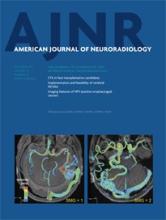Research ArticleBrain
Open Access
4D CT Angiography More Closely Defines Intracranial Thrombus Burden Than Single-Phase CT Angiography
A.M.J. Frölich, D. Schrader, E. Klotz, R. Schramm, K. Wasser, M. Knauth and P. Schramm
American Journal of Neuroradiology October 2013, 34 (10) 1908-1913; DOI: https://doi.org/10.3174/ajnr.A3533
A.M.J. Frölich
aFrom the Departments of Neuroradiology (A.M.J.F., D.S., R.S., M.K., P.S.)
D. Schrader
aFrom the Departments of Neuroradiology (A.M.J.F., D.S., R.S., M.K., P.S.)
E. Klotz
cSiemens AG (E.K.), Healthcare Sector, Computed Tomography, Forchheim, Germany.
R. Schramm
aFrom the Departments of Neuroradiology (A.M.J.F., D.S., R.S., M.K., P.S.)
K. Wasser
bNeurology (K.W.), University Medical Center Göttingen, Göttingen, Germany
M. Knauth
aFrom the Departments of Neuroradiology (A.M.J.F., D.S., R.S., M.K., P.S.)
P. Schramm
aFrom the Departments of Neuroradiology (A.M.J.F., D.S., R.S., M.K., P.S.)

Submit a Response to This Article
Jump to comment:
No eLetters have been published for this article.
In this issue
American Journal of Neuroradiology
Vol. 34, Issue 10
1 Oct 2013
Advertisement
A.M.J. Frölich, D. Schrader, E. Klotz, R. Schramm, K. Wasser, M. Knauth, P. Schramm
4D CT Angiography More Closely Defines Intracranial Thrombus Burden Than Single-Phase CT Angiography
American Journal of Neuroradiology Oct 2013, 34 (10) 1908-1913; DOI: 10.3174/ajnr.A3533
Jump to section
Related Articles
- No related articles found.
Cited By...
- Thrombus radiomics in patients with anterior circulation acute ischemic stroke undergoing endovascular treatment
- RAPID CT Perfusion-Based Relative CBF Identifies Good Collateral Status Better Than Hypoperfusion Intensity Ratio, CBV-Index, and Time-to-Maximum in Anterior Circulation Stroke
- Clot Burden Score and Collateral Status and Their Impact on Functional Outcome in Acute Ischemic Stroke
- Thrombus Permeability on Dynamic CTA Predicts Good Outcome after Reperfusion Therapy
- Slow Collateral Flow Is Associated with Thrombus Extension in Patients with Acute Large-Artery Occlusion
- Associations Between Collateral Status and Thrombus Characteristics and Their Impact in Anterior Circulation Stroke
- Association of clot burden score with radiographic and clinical outcomes following Solitaire stent retriever thrombectomy: analysis of the SWIFT PRIME trial
- Absent Filling of Ipsilateral Superficial Middle Cerebral Vein Is Associated With Poor Outcome After Reperfusion Therapy
- Evaluation of Collaterals and Clot Burden Using Time-Resolved C-Arm Conebeam CT Angiography in the Angiography Suite: A Feasibility Study
- Clot Burden Score on Baseline Computerized Tomographic Angiography and Intra-Arterial Treatment Effect in Acute Ischemic Stroke
- Radiation Dose Reduction in 4D Cerebral CT Angiography by Individualized Estimation of Cerebral Circulation Time
- Comparison of four different collateral scores in acute ischemic stroke by CT angiography
- Permeable Thrombi Are Associated With Higher Intravenous Recombinant Tissue-Type Plasminogen Activator Treatment Success in Patients With Acute Ischemic Stroke
- Prediction of Stent-Retriever Thrombectomy Outcomes by Dynamic Multidetector CT Angiography in Patients with Acute Carotid T or MCA Occlusions
- Thrombus Permeability Is Associated With Improved Functional Outcome and Recanalization in Patients With Ischemic Stroke
- Time-Resolved C-Arm Computed Tomographic Angiography Derived From Computed Tomographic Perfusion Acquisition: New Capability for One-Stop-Shop Acute Ischemic Stroke Treatment in the Angiosuite
- Dynamic Angiography and Perfusion Imaging Using Flat Detector CT in the Angiography Suite: A Pilot Study in Patients with Acute Middle Cerebral Artery Occlusions
- Optimal MRI Sequence for Identifying Occlusion Location in Acute Stroke: Which Value of Time-Resolved Contrast-Enhanced MRA?
- 4D-CTA in Neurovascular Disease: A Review
- Carotid I's, L's and T's: collaterals shape the outcome of intracranial carotid occlusion in acute ischemic stroke
- Relative Filling Time Delay Based on CT Perfusion Source Imaging: A Simple Method to Predict Outcome in Acute Ischemic Stroke
- Length of Occlusion Predicts Recanalization and Outcome After Intravenous Thrombolysis in Middle Cerebral Artery Stroke
This article has not yet been cited by articles in journals that are participating in Crossref Cited-by Linking.
More in this TOC Section
Similar Articles
Advertisement











